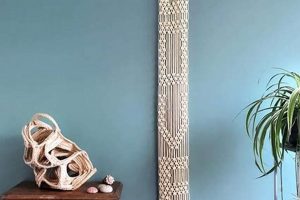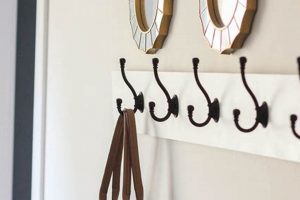The installation of decorative trim on vertical interior surfaces by individuals, rather than professional contractors, involves precise measurement, cutting, and adhering or fastening materials like wood, MDF, or polymers. An example would be a homeowner enhancing a living room by installing picture frame molding below an existing chair rail.
This pursuit offers potential cost savings compared to hiring a professional, allowing for customization to match individual aesthetics and budgets. Historically, such embellishments added architectural interest and signified status, evolving from elaborate plasterwork to more accessible prefabricated options. The practice contributes to improved property value and personal satisfaction.
Consequently, the following sections will outline essential tools and materials, detail the installation process step-by-step, and provide tips for achieving professional-looking results, along with insights into various design styles and maintenance considerations.
Essential Guidance for Decorative Wall Trim Installation
The following points are designed to assist individuals in achieving a high-quality finish when adding decorative trim to walls. Careful consideration of these guidelines can mitigate common errors and ensure a professional appearance.
Tip 1: Accurate Measurement is Paramount. Prior to cutting any material, precise measurements of the wall and molding are crucial. A laser level aids in establishing straight lines, reducing discrepancies that become magnified as the project progresses. Example: Double-check all measurements before making any cuts to avoid material waste.
Tip 2: Miter Cuts Demand Precision. When joining molding at corners, a high-quality miter saw is essential. Ensure the blade is sharp and set to the correct angle for a seamless joint. Example: Practice miter cuts on scrap material before cutting the final pieces.
Tip 3: Adhesives and Fasteners Must Be Compatible. Select appropriate adhesives and fasteners based on the wall surface and molding material. Using the wrong adhesive can result in poor adhesion and failure of the installation. Example: For plaster walls, consider using construction adhesive combined with finish nails.
Tip 4: Proper Surface Preparation is Key. Before installing any trim, ensure the wall surface is clean, dry, and free of loose paint or debris. This promotes optimal adhesion and prevents future issues. Example: Lightly sand glossy paint surfaces to improve adhesion.
Tip 5: Fill Nail Holes and Gaps for a Seamless Finish. After installation, fill any nail holes or gaps with wood filler or caulk that matches the molding color. Sand smooth and paint for a professional, undetectable finish. Example: Use paintable caulk along the top edge of the molding where it meets the wall to conceal minor imperfections.
Tip 6: Consider the Room’s Existing Style. Integrate the new trim seamlessly with the existing architectural style of the room. Choose molding profiles and paint colors that complement the existing decor. Example: In a modern space, opt for simpler, more minimalist molding styles.
By implementing these guidelines, individuals can significantly improve the outcome of decorative trim projects, enhancing the aesthetic appeal of interior spaces.
The subsequent sections will delve into specific design styles and provide a comprehensive overview of maintenance procedures to ensure the longevity of the installed trim.
1. Material Selection
The selection of materials represents a foundational decision in the execution of decorative trim installation. This choice impacts not only the project’s cost but also the ease of installation, aesthetic outcome, and overall longevity. Careful consideration of available options is therefore paramount.
- Wood: Traditional Elegance and Durability
Solid wood offers a classic aesthetic and inherent structural integrity. Options range from softwood varieties like pine to hardwoods like oak and maple. Wood accepts paint and stain exceptionally well, allowing for a high degree of customization. However, it is generally more expensive and can be prone to warping or cracking in environments with fluctuating humidity. A real-world application includes the use of oak molding in a historic home to maintain authenticity.
- Medium-Density Fiberboard (MDF): Cost-Effectiveness and Consistency
MDF is an engineered wood product composed of wood fibers bound together with resin. It provides a smooth, consistent surface that is ideal for painting. MDF is typically more affordable than solid wood and less susceptible to warping. However, it is more prone to water damage and less durable under impact. This choice is often found in residential projects seeking a balance between cost and aesthetic appeal.
- Polystyrene: Moisture Resistance and Lightweight Properties
Polystyrene molding is a synthetic option offering superior resistance to moisture, making it suitable for bathrooms and kitchens. It is lightweight, simplifying installation, and often pre-primed for painting. However, polystyrene may lack the detail and feel of wood or MDF and can be more susceptible to dents and scratches. It often provides an economical and practical solution in humid environments.
- Polyurethane: Detailed Designs and Durability
Polyurethane molding offers intricate detailing and enhanced durability compared to polystyrene. It is resistant to moisture, warping, and insect damage. While generally more expensive than MDF or polystyrene, it provides a durable and aesthetically pleasing alternative to wood in certain applications. Consider polyurethane when seeking complex profiles and longevity, especially in potentially damp spaces.
Each material presents a unique set of advantages and disadvantages that must be weighed against the project’s specific requirements and constraints. The ultimate choice should align with the desired aesthetic, budget limitations, and environmental conditions to ensure a successful outcome. Selecting the correct material is important to the longevity and visual outcome of the installation.
2. Accurate Measurements
The precision of measurements serves as a foundational element for successful decorative trim installation. Deviations from accuracy cascade through subsequent phases, impacting material utilization, joint integrity, and the final aesthetic outcome.
- Material Optimization
Precise measurements reduce material waste. Overestimation leads to unnecessary purchases, while underestimation necessitates additional trips to suppliers. An example includes calculating linear footage for baseboard installation, where inaccurate measurements can result in insufficient material to complete the project or leftover material incurring costs. Material optimization directly impacts budgetary constraints.
- Miter Joint Integrity
The creation of seamless miter joints at corners hinges on accurate angle calculations and precise cuts. A discrepancy of even a fraction of a degree can manifest as a visible gap. Consider a room with several corners; inaccurate angle measurements will compound across each joint, producing an unprofessional finish. Proper measurements prevent light gaps and ensure a visually appealing transition.
- Wall Coverage Consistency
Maintaining consistent spacing and alignment of trim elements requires accurate measurements. Inconsistent spacing, resulting from measurement errors, can disrupt the visual harmony of the installation. For instance, picture frame molding installed with uneven spacing will create an unbalanced aesthetic, detracting from the intended design. Symmetry and visual balance are dependent on accurate measurement.
- Installation Efficiency
Accurate measurements contribute to a streamlined installation process. The need for repeated adjustments and recuts due to initial errors increases labor time and project complexity. A project involving multiple trim pieces benefits significantly from accurate initial measurements, minimizing the time spent on adjustments and promoting a faster, more efficient workflow. Reduced installation time translates to lowered labor costs, in a professional setting.
The interdependency between accurate measurements and all facets of decorative trim installation underscores the critical nature of this initial step. Accurate measurements serve as a linchpin, influencing material usage, joint quality, visual appeal, and overall project efficiency, which directly impact the success of decorative trim endeavors. Avoiding measuring errors makes a huge difference in this process.
3. Precise Cutting
The execution of any decorative trim installation relies heavily on precise cutting techniques. Inaccurate cuts compromise the integrity of the design, leading to visible imperfections and potentially requiring costly material replacement. Success in this field is intrinsically linked to the ability to achieve accurate cuts.
- Mitered Corner Accuracy
Achieving seamless corners hinges on the precision of miter cuts. Each cut must be executed at the precise angle to ensure a tight, visually appealing joint. In the case of a 45-degree miter, even a fraction of a degree off can result in a visible gap. Real-world applications include door frames, window trim, and crown molding installations, where accurate mitered corners are essential for a professional finish. The overall success of the project will hinge on the accuracy of the miter joint.
- Cope Joint Integrity
Cope joints, used to fit molding to irregular or curved surfaces, demand precise cutting and shaping. The process involves removing material from the back of the molding to create a profile that matches the existing surface. An example of this is fitting baseboard molding around a curved archway, where careful coping ensures a tight fit. A bad cope joint will reveal gaps and prevent a professional finish.
- Straight Cut Consistency
The ability to consistently execute straight cuts is crucial for creating clean lines and uniform trim elements. Even slight deviations can become magnified across multiple pieces of molding, leading to visual inconsistencies. This is particularly relevant in applications such as chair rail installations, where consistent height and alignment are paramount. All cut edges need to be uniform in straightness and dimension.
- Material Specific Techniques
Different materials require specific cutting techniques to achieve optimal results. Wood, MDF, and polystyrene each respond differently to saw blades, necessitating adjustments in cutting speed, blade type, and cutting angle. For example, cutting MDF requires a blade designed to minimize chipping, while wood may require a finer tooth blade to prevent splintering. Selecting the proper cutting method for a specific material ensures clean cuts and reduces material waste.
Precise cutting is, therefore, a cornerstone of the entire endeavor. It directly impacts the aesthetic outcome, material utilization, and overall project efficiency. Proficiency in cutting techniques, coupled with the appropriate tools, significantly increases the likelihood of a successful and visually appealing finished product.
4. Secure Attachment
Secure attachment constitutes a critical phase in the execution of decorative trim installation. The method employed to affix molding to the wall directly influences the longevity, stability, and overall aesthetic integrity of the finished project. Failure to ensure a robust connection can lead to detachment, misalignment, and compromise the intended visual appeal. This holds particularly true for DIY applications, where an understanding of appropriate techniques and materials is essential.
The choice of attachment method is contingent upon the substrate (wall material) and the molding material. For instance, drywall often necessitates the use of both adhesive and fasteners (nails or screws) to distribute the load and prevent the molding from pulling away over time. Conversely, plaster walls may require specialized adhesives or mechanical fasteners designed to penetrate the hard surface without causing damage. Improper attachment, such as using solely adhesive on a heavy wood molding applied to drywall, will almost certainly result in failure, necessitating repairs and potential material replacement. The secure connection method is not universal but varies according to the materials used.
In summary, secure attachment is non-negotiable for the success of decorative trim installations. It demands careful assessment of materials, appropriate technique selection, and meticulous execution. A lack of attention to this aspect not only diminishes the aesthetic value of the project but also potentially leads to costly repairs and safety hazards, in particular for those performing a project alone. A poor secure attachment will require re-attachment down the road.
5. Seamless Finishing
The execution of decorative wall trim projects necessitates seamless finishing for achieving a professional aesthetic. It represents a crucial step, transforming raw installation into a cohesive architectural detail. It addresses visible imperfections, ensuring a smooth transition between the installed trim and the existing wall surface. Without it, nail holes, gaps, and uneven joints detract from the overall appearance. For example, a homeowner installing crown molding must address gaps between the molding and the ceiling with caulk, followed by painting to blend the repair seamlessly with the surrounding surfaces. This process ensures the trim appears as an integral part of the room’s design, rather than a tacked-on addition.
The application of wood filler to conceal nail holes and imperfections exemplifies another aspect of seamless finishing. Once dried, the filler is sanded smooth, creating a uniform surface ready for priming and painting. Consistent sanding techniques further enhance the finished product, creating smooth and continuous transitions. The proper technique is important to eliminate high spots or uneven patches, which would be visible once painted. A DIYer installing chair rail molding would likely need to fill nail holes from the brad nailer, sand the filler flush, and prime the molding before the final coat of paint. This attention to detail exemplifies the pursuit of a high-quality outcome.
Achieving a seamless finish constitutes a vital element within a successful wall trim project. It enhances visual appeal, elevates perceived value, and transforms a basic installation into a polished addition. Challenges may arise when matching existing paint colors or replicating specific textures. In conclusion, successful completion of such endeavors necessitates both knowledge of materials and processes and commitment to meticulous execution. This phase provides a professional look.
6. Design Harmony
Decorative wall trim installation, when undertaken as a DIY project, demands a crucial integration with existing architectural and interior design elements. This integration, termed “Design Harmony,” dictates the success or failure of the project in achieving a cohesive and aesthetically pleasing outcome. The selection of molding profiles, materials, and finishes must complement the room’s style, scale, and existing features to prevent visual discord. Failing to establish this harmony results in a trim installation that appears incongruous and detracts from the room’s overall appeal. A modern, minimalist space, for example, would clash with ornate, Victorian-style molding, creating a visually jarring experience.
The importance of Design Harmony extends beyond stylistic considerations. The scale and proportion of the molding must align with the dimensions of the room and the height of the walls. Oversized molding in a small room can overwhelm the space, while undersized trim may appear insignificant and lack visual impact. Real-world examples illustrate this principle: a large living room with high ceilings can accommodate substantial crown molding, whereas a small bedroom requires more delicate and understated trim profiles. Furthermore, the choice of paint color or finish should coordinate with the existing color palette and textures in the room. A mismatch in color or finish can disrupt the visual flow and create a sense of disharmony.
In conclusion, achieving Design Harmony is not merely an aesthetic preference but a fundamental prerequisite for successful DIY wall trim installation. Careful consideration of architectural style, room scale, and existing design elements ensures a cohesive and visually appealing result. This understanding underscores the importance of thorough planning and research before commencing any DIY trim project. Prioritizing Design Harmony transforms what could be a disjointed addition into an integral, and complementary, part of the interior space.
7. Cost Management
The successful execution of decorative wall trim installation, particularly in a DIY context, is inextricably linked to effective cost management. The budgetary constraints often associated with DIY projects necessitate careful planning and resource allocation. Improper cost management can lead to project abandonment, compromised quality, or exceeding initial financial projections. Consequently, understanding the interplay between cost and various project phases is essential. Cost management can make the decision on the project and materials used
Cost management in this context encompasses several key aspects. Material selection represents a primary driver of project expenses. Opting for less expensive alternatives, such as MDF over solid wood, directly impacts the overall material cost. However, this decision also affects durability and aesthetic appeal, necessitating a careful balancing act. Furthermore, accurate measurement and precise cutting techniques minimize material waste, thereby reducing expenses. Neglecting these aspects leads to unnecessary material purchases and increased project costs. Similarly, the choice between hiring professional assistance for complex tasks, such as miter cutting or opting for more basic designs that can be executed independently, influences labor expenses. The choice of the paint materials also affect cost considerations as well. DIY gives many more options to save costs compared to hiring a professional.
In summary, effective cost management is crucial for realizing decorative wall trim installation within budgetary limitations. It necessitates meticulous planning, informed material selection, and efficient execution. Neglecting cost considerations compromises the project’s viability and potentially results in financial strain. Mastering cost management ensures project completion without sacrificing quality or exceeding available resources. The ability to handle the budget is a critical skill during DIY, and its what separates success from failure.
Frequently Asked Questions Regarding Decorative Wall Trim Installation
The following addresses prevalent inquiries regarding decorative wall trim installation, offering insights into various aspects of the process.
Question 1: What essential tools are required for wall molding DIY?
A miter saw, measuring tape, level (laser level recommended), pencil, safety glasses, construction adhesive, caulk, nail gun (optional), wood filler, sandpaper, and paint are essential for successful execution.
Question 2: What are common types of wall molding suitable for DIY projects?
Baseboard, chair rail, picture frame molding, and crown molding are frequently used in DIY projects. Selection depends on skill level and design preference.
Question 3: How does one accurately measure and cut wall molding for precise fitting?
Precise measurements are critical. Double-check all measurements before cutting. A laser level aids in establishing straight lines. Use a miter saw for accurate angle cuts, practicing on scrap material beforehand.
Question 4: What factors influence the choice between using nails versus adhesive for wall molding DIY?
Wall material, molding weight, and desired permanency are key factors. Adhesive is often used in conjunction with nails for added stability, especially on drywall. Plaster walls may require specialized adhesives.
Question 5: What steps are involved in achieving a seamless finish for wall molding DIY?
Filling nail holes with wood filler, sanding smooth, caulking gaps, priming, and painting are crucial steps. Matching paint colors ensures a cohesive appearance.
Question 6: How does one prevent common wall molding DIY mistakes, such as uneven lines or gapping corners?
Accurate measurements, precise cuts, careful installation, and the use of a level are essential. Practice miter cuts and cope joints to minimize gapping. Use shims to correct uneven walls.
Careful planning, accurate execution, and attention to detail are paramount for achieving satisfactory results in decorative wall trim installation.
The subsequent section will provide a comprehensive glossary of relevant terms related to decorative wall trim and their definitions.
Conclusion
The preceding discussion has explored the multifaceted aspects of “wall molding diy,” underscoring the importance of meticulous planning, precise execution, and informed decision-making throughout the process. Key points highlighted include material selection, accurate measurement, precise cutting techniques, secure attachment methods, seamless finishing practices, design harmony considerations, and effective cost management strategies. The complexity of the undertaking demands a comprehensive understanding of each facet to achieve a successful and aesthetically pleasing outcome.
Ultimately, decorative wall trim installation, when approached with diligence and skill, represents a valuable opportunity to enhance interior spaces. The insights provided serve as a foundation for informed action. Further study, practice, and attention to detail are encouraged to fully realize the potential of this transformative endeavor, resulting in improved property value and increased personal satisfaction.







